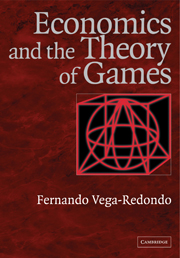Book contents
- Frontmatter
- Contents
- Preface
- 1 Theoretical framework
- 2 Strategic-form analysis: theory
- 3 Strategic-form analysis: applications
- 4 Refinements of Nash equilibrium: theory
- 5 Refinements of Nash equilibrium: applications
- 6 Incomplete information: theory
- 7 Incomplete information: applications
- 8 Repeated interaction: theory
- 9 Repeated interaction: applications
- 10 Evolution and rationality
- 11 Learning to play
- 12 Social learning and equilibrium selection
- Bibliography
- Index
12 - Social learning and equilibrium selection
Published online by Cambridge University Press: 03 June 2010
- Frontmatter
- Contents
- Preface
- 1 Theoretical framework
- 2 Strategic-form analysis: theory
- 3 Strategic-form analysis: applications
- 4 Refinements of Nash equilibrium: theory
- 5 Refinements of Nash equilibrium: applications
- 6 Incomplete information: theory
- 7 Incomplete information: applications
- 8 Repeated interaction: theory
- 9 Repeated interaction: applications
- 10 Evolution and rationality
- 11 Learning to play
- 12 Social learning and equilibrium selection
- Bibliography
- Index
Summary
Introduction
In this final chapter, we turn to the important issue of equilibrium selection in games, a problem that has been mostly neglected thus far. It is, however, a key issue in many game-theoretic models of economic phenomena (in particular, several of those studied in this book), which happen to display a wide multiplicity of equilibria. In those cases, one must find ways to overcome the induced “equilibrium indeterminacy” if a definite theoretical prediction is to be obtained.
The equilibrium selection problem typically is not mitigated if, rather than approaching matters statically (i.e., from an equilibrium viewpoint), a dynamic process reflecting off-equilibrium learning is postulated instead. For then, analogous considerations appear in that, often, the limit behavior of the learning process depends sharply on its initial conditions (cf. Chapter 11). Consequently, since one seldom has a convincing theory about how the initial conditions might be determined, such a dynamic approach, by itself, seldom represents a suitable solution to the problem.
To address the issue of equilibrium selection, the route to be undertaken here is reminiscent of ideas that, albeit with somewhat different motivation, have been pursued at other points in this book – e.g., concerning Nash refinements. Specifically, we conduct a robustness exercise, now applied to some of the basic learning models discussed in Chapter 11, i.e., imitation and best-response dynamics. That is, these dynamics are perturbed slightly, in the hope that such a perturbation may remove any dependence of initial conditions and thus single out a “uniquely robust” limit behavior.
- Type
- Chapter
- Information
- Economics and the Theory of Games , pp. 446 - 500Publisher: Cambridge University PressPrint publication year: 2003



